LG G2 and MSM8974 Snapdragon 800 - Mini Review
by Brian Klug on September 7, 2013 1:11 AM EST- Posted in
- Smartphones
- LG
- Mobile
- LG G2
- Android 4.2
- MSM8974
- Snapdragon 800
GPU Performance
Snapdragon 800 features Qualcomm's Adreno 330 GPU. Qualcomm hasn't stated publicly how Adreno 330 compares to Adreno 320 featured in Snapdragon 600, but it's almost certainly a larger GPU. The 8974 implementation in LG's G2 clocks the Adreno 330 GPU at a maximum of 450MHz, yet we see better performance than the 450MHz Adreno 320 in Snapdragon 600 - lending credibility to the idea of having more execution resources. There's also an 8974AB variant which includes a 100 MHz bump in GPU clocks up to 550 MHz.
3DMark
3DMark for Android features the Ice Storm benchmark and uses OpenGL ES 2.0. Ice Storm is divided into two graphics tests and a physics test. The first graphics test is geometry heavy while the second test is more pixel shader intensive. The physics test, as you might guess, is CPU bound and multithreaded. The overall score takes into account both graphics and physics tests. The benchmark is rendered to an offscreen buffer at 720p/1080p and then scaled up to the native resolution of the device being tested. This is a very similar approach we've seen by game developers to avoid rendering at native resolution on some of the ultra high resolution tablets. The beauty of 3DMark's approach here is the fact that all results are comparable, regardless of a device's native resolution. The downside is we don't get a good idea of how some of the ultra high resolution tablets would behave with these workloads running at their native (> 1080p) resolutions.
For these benchmarks we stuck with the default presets (720p, normal quality).
3DMark performance generally fell very close to Qualcomm's MSM8974 MDP/T, with one exception. The CPU bound physics tests had the G2 far lower down the list than I would've expected. Given that test is mostly a multithreaded CPU benchmark, it's entirely possible that the G2's thermal/frequency governors are set more conservatively there. The performance gains elsewhere over Snapdragon 600/Adreno 320 are huge, but 3DMark can be very influenced by CPU performance so it's not clear how much of this advantage is due to Adreno 330 or Krait 400.
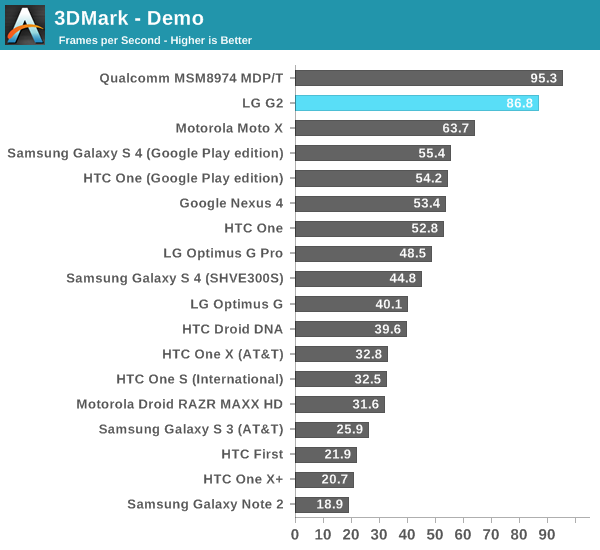
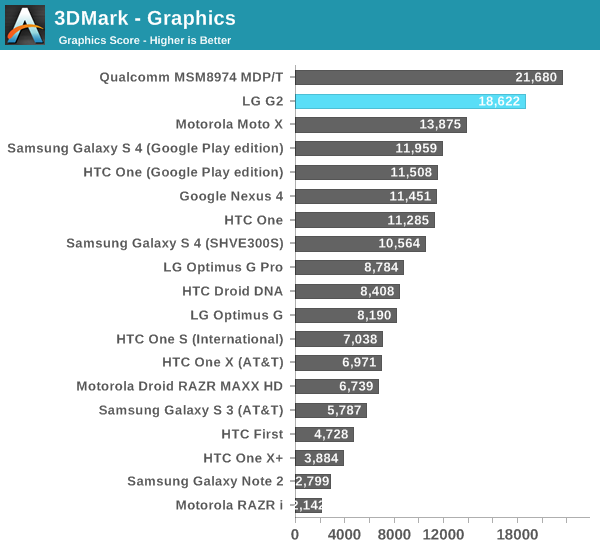
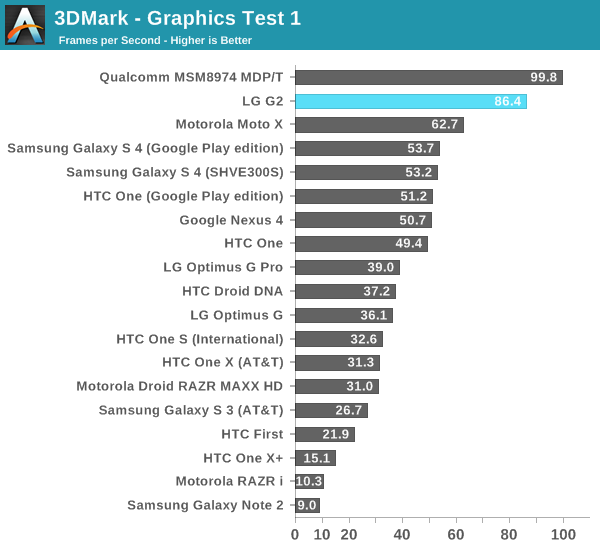
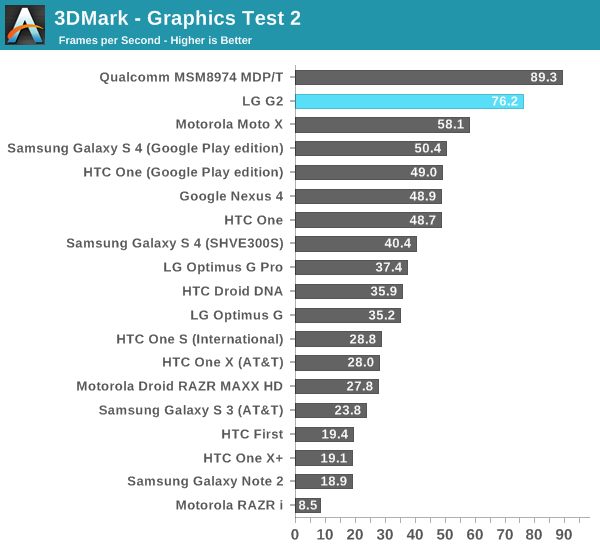
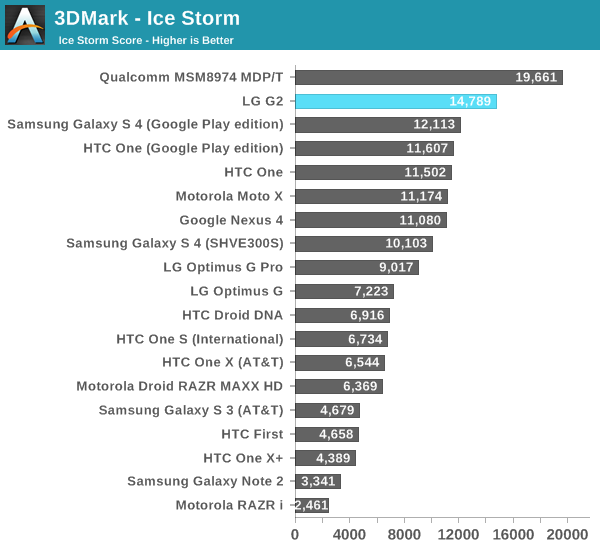
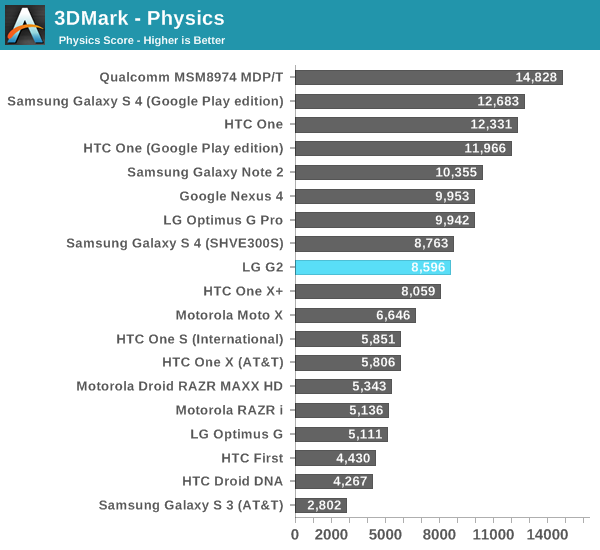
GFXBench 2.7
GFXBench (formerly GLBenchmark) gives us some low level insight into these platforms. As usual, we'll start with the low level tests and move onto the game simulation benchmarks:
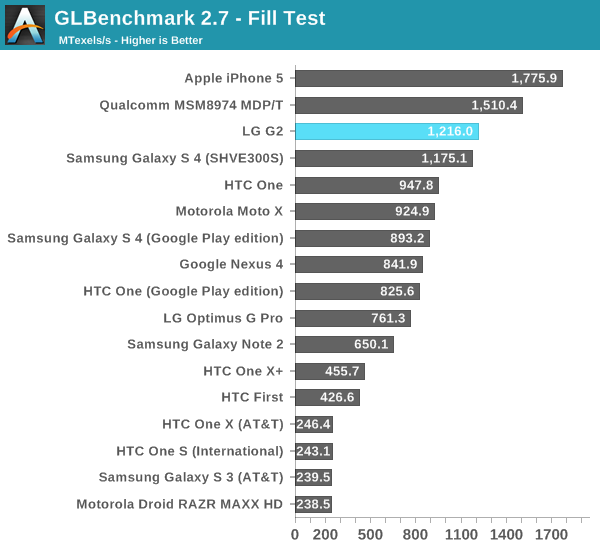
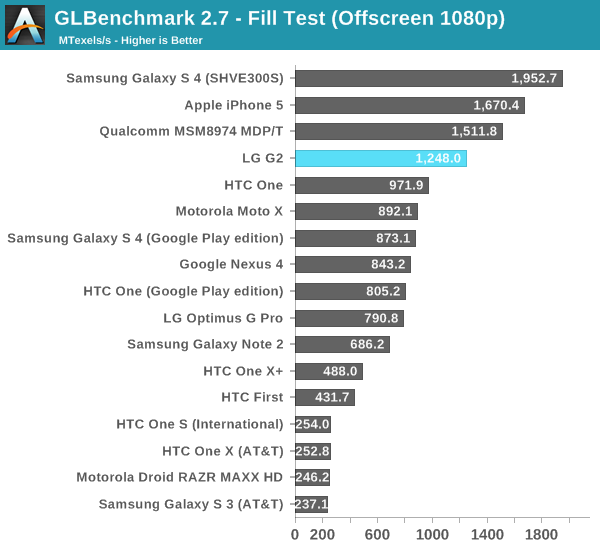
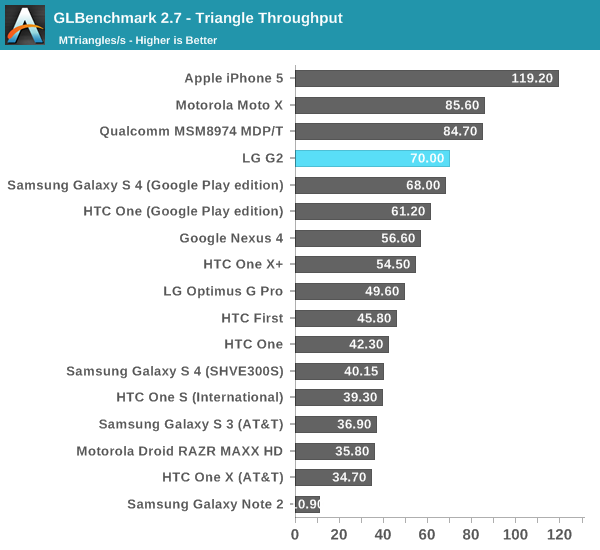
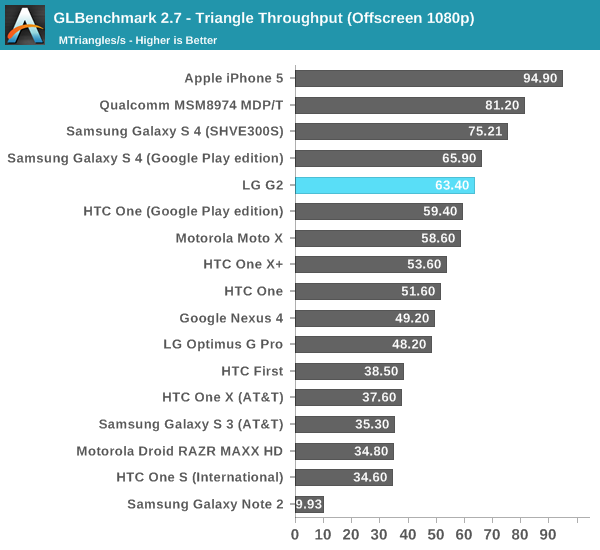
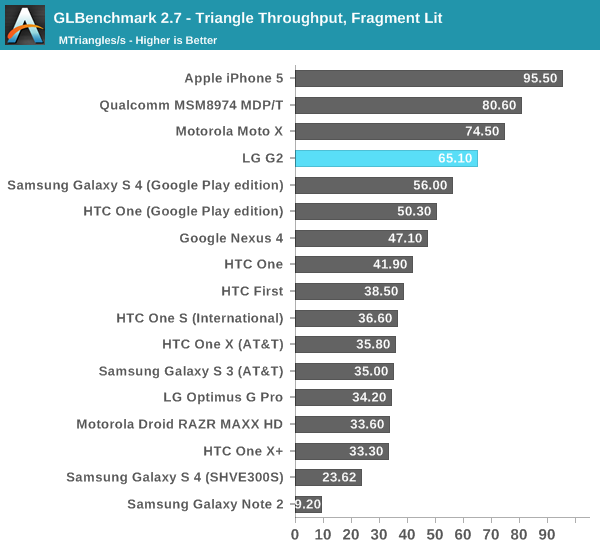
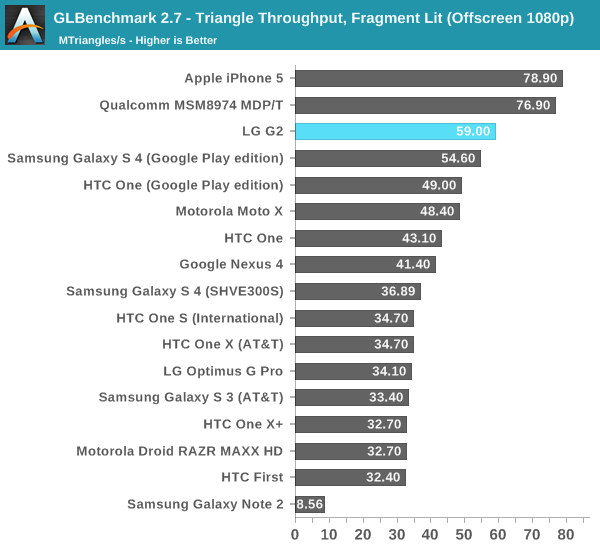
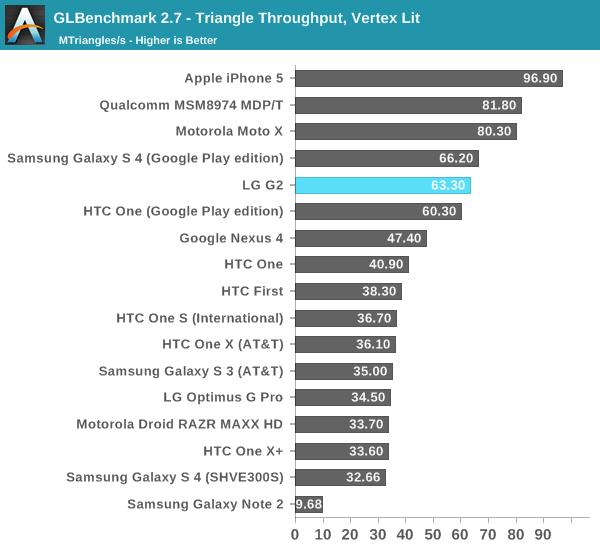
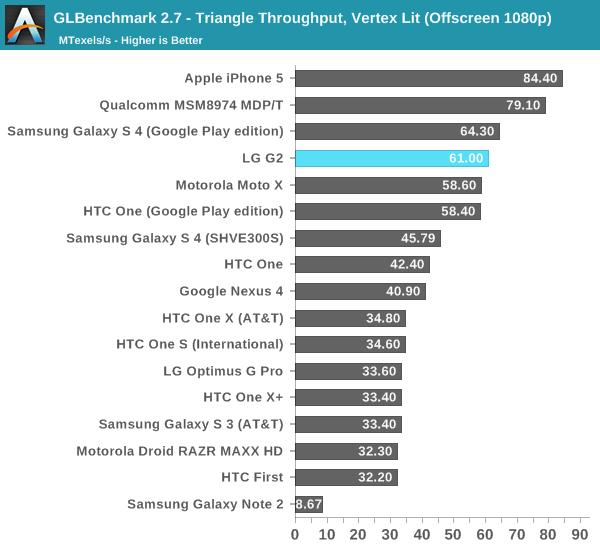
The low level tests put the G2 closer in performance to some of the Snapdragon 600 based devices than the MDP/T, again early software at work here. The T-Rex HD performance looks pretty good, putting the G2 between the S600 devices and S800 MDP/T.
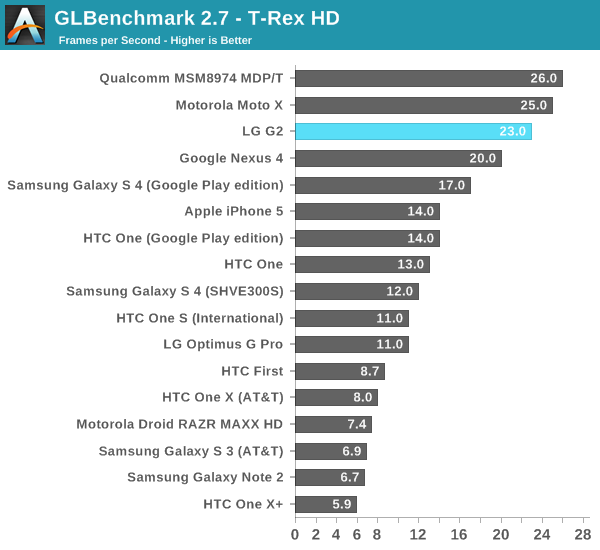
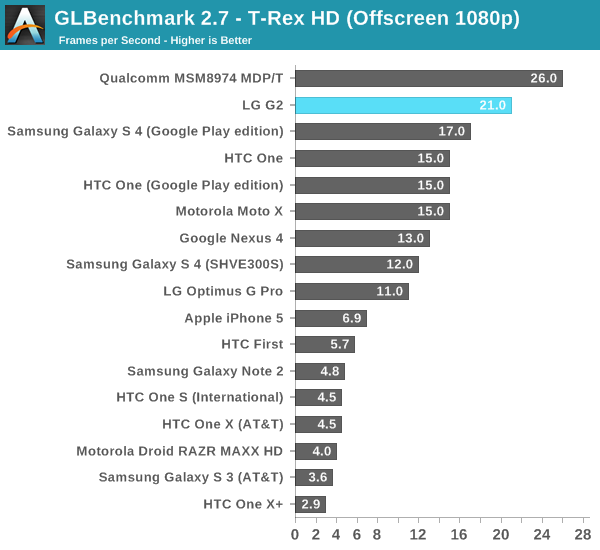
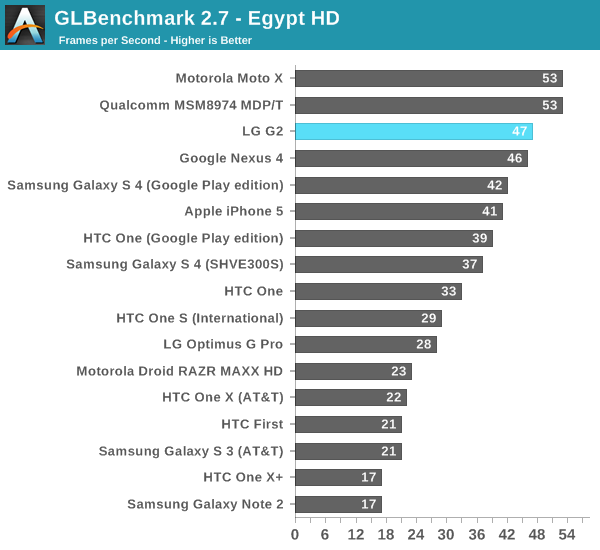
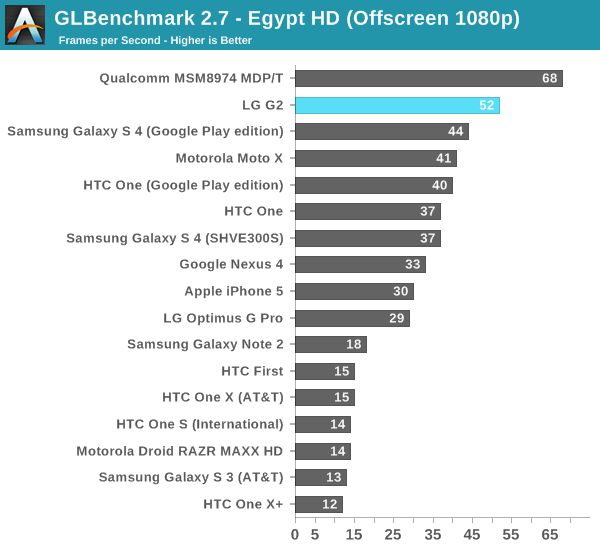
Basemark X
Basemark X is a new addition to our mobile GPU benchmark suite. There are no low level tests here, just some game simulation tests run at both onscreen (device resolution) and offscreen (1080p, no vsync) settings. The scene complexity is far closer to GLBenchmark 2.7 than the new 3DMark Ice Storm benchmark, so frame rates are pretty low:

Basemark X performance tracks with what we saw in the GFXBench T-Rex HD test. Performance is clearly higher than on any other device, but not quite up to MDP/T levels. I wonder how much closer the final device will get.
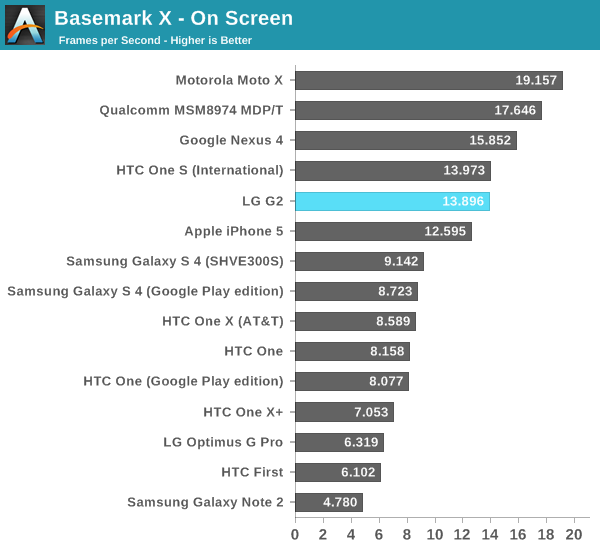
Epic Citadel
Epic's Citadel benchmark gives us a good indication of lighter workload, v-sync limited performance at native resolution. At 1080p, the Snapdragon 800 MDP/T offers over 50% better performance than the Snapdragon 600 based platforms. Granted we're comparing to smartphones here so there's some thermal advantage playing to the 800's favor.
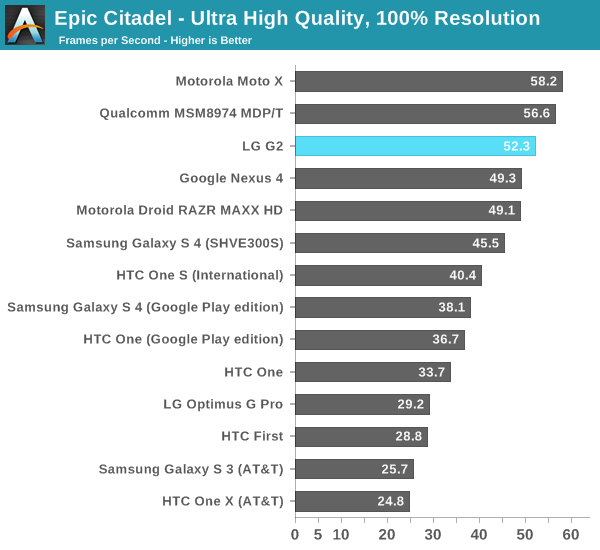










120 Comments
View All Comments
KurianOfBorg - Saturday, September 7, 2013 - link
What about the suttering and lag? I used the Optimus G Pro and it stuttered and lagged everywhere. No where close to the smoothness of the Nexus 4.Brian Klug - Saturday, September 7, 2013 - link
I find it to be really smooth, of course if you want absolute smoothness, you can just wait for 8974 in the Nexus 5 :)-Brian
htotfalitm - Saturday, September 7, 2013 - link
good. I'm glad they ditched capacitive controlsI hated onscreen controls too but I've been completely sold on the idea since I tried Paranoid Android and discovered Pie Control
baronmog - Saturday, September 7, 2013 - link
I feel like a broken record: only 32GB onboard storage and no microSD? No thanks. I really, really, really, wish someone other than Samsung would get their heads out of the cloud. It's ok when you're someplace with decent, or any, wireless connectivity. Otherwise, useless.HideOut - Saturday, September 7, 2013 - link
I want to trade off my S4 for this...but no microSD? FAIL.BabelHuber - Saturday, September 7, 2013 - link
Exactly my thoughts!When I see reviews at Anandtech, often my first thought is 'wow, what a nice phone!'-
Then I see that the SD-card is missing and the phone has died for me.
Samsung seems to be very smart in this area. They always have removable batteries, SD-card support and unlocked bootloaders.
And while Samsung breaks one sales record after another quarter by quarter, LG and HTC are wondering why most customers prefer their competitor's devices.
I don't think that this is coincidence. E.g. I personally like the look and feel of the HTC One, but the lacking flexibility turned me off immediately.
Android games like the Asphalt-series consume about 1.5GB meanwhile. A 16GB phone without SD-card support is a joke meanwhile.
32GB are OK, but still inferiour to an external 64GB SD-card. Once you root your device, you can set mount points to the external SD-card or - in case you are lazy like me - use an app like FolderMount to at least move the apps which are memory-hogs to the external SD.
How much can it cost to support such a feature? LG, HTC etc. are clueless and deserve their low market share with their crippled devices, really.
They should wake up and support SD-cards so we get more competition. But no, instead the champaign flows at Samsung while the managers laugh about the competition.
maximumGPU - Saturday, September 7, 2013 - link
You're talking as if LG and HTC's low market share is attributable to lack of SD support. It has practically nothing to do with this.You do understand that people requesting SD support are a minority that barely register in sales number?
BabelHuber - Saturday, September 7, 2013 - link
This is what I always hear. But I do not believe this.Why are people buying 70 Million Samsung smartphones per quarter, then? Just because 'Samsung' is printed on them?
In basically every store, HTC, Samsung, LG and Sony phones are sold. People walk in and mostly buy Samsung.
And this has nothing to do with the additional features Samsung offers for the same price? Come on!
UpSpin - Saturday, September 7, 2013 - link
Just take a look at how much money Samsung spends on advertising, then you'll understand why the Samsung smartphones are the most sold ones.http://www.imore.com/samsung-spending-ludicrously-...
http://online.wsj.com/article/SB100014241278873240...
Most people really don't care about SD-Cards, for some it's even an annoyance because you can't combine the phone storage with the SD-Card storage, so you can't use it for apps and other stuff. And it's much slower than eMMC and another part which can and will fail after extensive usage.
Thus a phone with 8GB internal + 64GB SD-Card is almost as worthless as a phone with 8GB only for the !majority of people!
The big advantage comes with storing music libraries, movie libraries, ... on the SD-Card, but there again, the majority of users does not have a 64GB music library, and barely DVD/Blu-Ray rips, they rather rely on streaming.
BabelHuber - Saturday, September 7, 2013 - link
First of all, I already have posted that using the SD-card for apps is child's play after the phone has been rooted. Just root, install FoulderMount and off you go.Then you can use the SD-card for Music, movies etc., while music probably being the major use-case for most people, as a solt of people use their phone as 'walkman' or use it as music data storage in their cars.
So simply stating that an SD-card does not give you benefits ist BS.
And yes, marketing is an explanation for higher market share. But this alone does not explain why Samsung has ten times the marketshare of its competitors.
Tomi Ahonen called the smartphone market 'Samsung, Apple and the nine dwarfes', which is correct IMO.
A lot of people walk into a store and don't have much clue. Then the sales guy shows them the phones and explains the advantages/ disadvantages.
So, if you are not much interested in the HTC One's speakers, you can also take the SGS4. It has a removable battery and an SD-card slot and costs the same.
Why take the phone with less options? It simply does not make sense - after all, if you never use the SD-card slot it does not matter because you payed no premium for it.
But simply stating that customers are too stupid to properly use SD-cards falls short when Samsung has so much success with phones equipped with such features.